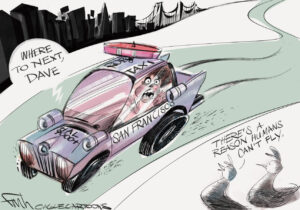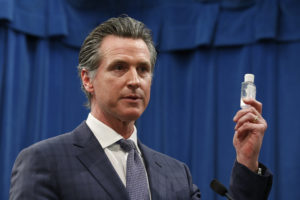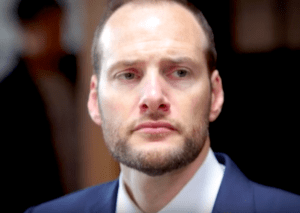Crack in Beam Shuts San Francisco’s New $2.2 Billion Terminal
A downtown street that runs under the beam is ordered closed indefinitely. With some other streets blocked off for a conference, traffic chaos results.SAN FRANCISCO — San Francisco officials shut down the city’s celebrated new $2.2 billion transit terminal Tuesday after discovering a crack in a support beam under the center’s public roof garden.
Coined the “Grand Central of the West,” the Salesforce Transit Center opened in August near the heart of downtown after nearly a decade of construction. It was expected to accommodate 100,000 passengers each weekday, and up to 45 million people a year.
The center is operated by the Transbay Joint Powers Authority and its executive director Mark Zabaneh said workers discovered the crack around 10 a.m. while replacing roofing tiles. Zabaneh said engineers spent the day inspecting the damage and decided to shut the station around 5 p.m., just as the afternoon rush hour started.
“The beam is cracked,” Zabaneh said. “The behavior of the beam is unpredictable.”
Zabaneh said the crack was found near a weld on a stress-bearing horizontal beam. He said he did not know how long the crack was, but he told reporters that American steel was used in the center’s construction.
Zabaneh said the cause and the extent of the damage were unknown and the decision to close the terminal was made out of an “abundance of caution.”
He said structural engineers would be working at the building Tuesday night to assess whether it is safe for people to return.
Buses were rerouted to a temporary transit center about two blocks away that was used during the center’s construction. A downtown street that runs under the beam was also ordered closed indefinitely, causing traffic chaos at the same time some streets were closed for a conference sponsored by Salesforce that was expected to draw 170,000 attendees.
Enveloped in wavy white sheets of metal veil, the five-level center includes a bus deck, a towering sky-lit central entrance hall and a rooftop park with an outdoor amphitheater.
The San Francisco Chronicle reported that the complex faced delays in putting out contracts to bid, and the winning bids were ultimately higher than expected. The terminal’s cost rose from $1.6 billion at its 2010 groundbreaking to more than $2 billion in 2016 because of what one analyst called “optimistic assumptions,” according to the Chronicle.
The project, a commanding presence in the city’s South of Market neighborhood, is financed by land sales, federal stimulus grants, district fees and taxes, bridge tolls, and federal and state funds.
It sits adjacent to another dubious landmark, the so-called sinking condominium, Millennium Tower, which has settled about 18 inches (45 centimeters) since it opened over a former landfill in 2009. Homeowners have filed multiple lawsuits against the developer and the city, some alleging that construction of the transit center caused the Millennium Tower’s sinking.
Zabaneh said he did not believe that the cracked beam was related to ongoing problems at Millennium Tower.
The online business software company Salesforce, which opened its adjacent 61-story Salesforce Tower three months ago, bought naming rights to the center in 2017 as part of a 25-year, $110 million sponsorship agreement.
Your support matters…Independent journalism is under threat and overshadowed by heavily funded mainstream media.
You can help level the playing field. Become a member.
Your tax-deductible contribution keeps us digging beneath the headlines to give you thought-provoking, investigative reporting and analysis that unearths what's really happening- without compromise.
Give today to support our courageous, independent journalists.






You need to be a supporter to comment.
There are currently no responses to this article.
Be the first to respond.